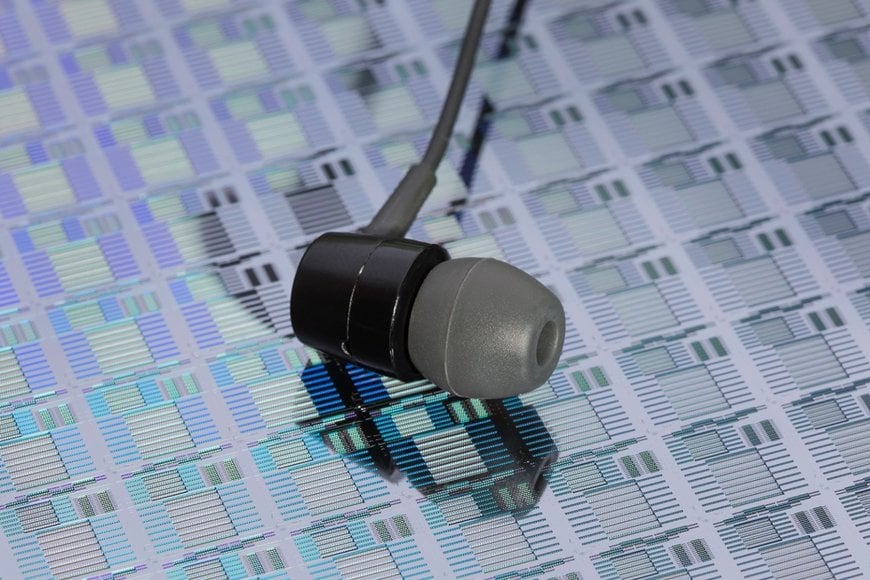electronics-journal.com
11
'21
Written on Modified on
Big sound, tiny speaker - Innovative modeling approach for micro loudspeakers
The Internet of Things and especially the Internet of Voice require energy-efficient and high-quality audio devices. In-ear headphones are a particular challenge in this regard. These battery-powered miniature devices are expected to cover an ever-increasing range of functions. An innovative loudspeaker technology developed by the Fraunhofer Institute for Photonic Microsystems IPMS represents an important development push due to its small size and high energy efficiency. New research results enabling order-reduced modeling have now been presented in the Nature Journal Microsystems & Nanoengineering.

The loudspeaker technology developed by Fraunhofer IPMS, with its silicon-based sound transducer principle, which no longer has a conventional membrane, is a novelty. Instead, the membrane has been cut into strips which are combined in a silicon chip in the form of a large number of bending bars - similar to the strings of a harp. With their integrated electrostatic drive, the bending bars, which are which are not wider than the fraction of a hair, form a completely new class of bending actuators. When an audio signal voltage is applied, they are excited to oscillate and generate audible sound waves. By integrating all components directly in the silicon chip, these sound generators are much smaller and more energy-efficient than conventional loudspeakers. This new type of extremely small micro-speaker now offers the space to integrate a wide range of additional functionalities into future in-ear headphones. For example, they allow smart hearable applications such as instant translation, payment functions and other Internet services - all voice-controlled and without looking at the smartphone. These multi-talents could even take over complete Internet communication in the future.
New research results on order-reduced modeling.
In the course of further development and research of this innovative speaker technology by Fraunhofer IPMS, another paper has now been published, which appeared in the Nature Journal Microsystems & Nanoengineering. Electrostatic deflected microbeams are widely used in the world of micro-electro-mechanical systems (MEMS) and have a high priority given current technological trends. In particular, the development of complex systems with many individual MEMS components relies on the existence of reliable reduced-order models. In this context, reduced-order models can describe the location dependence of the deflection of a beam with a single degree of freedom, which greatly simplifies the solution of the associated equations, or often makes it possible in the first place.
However, the behavior of microbeams is highly nonlinear, which makes deriving such models challenging, as many such degrees of freedom are needed to achieve reasonable accuracy. "In this paper, an important step has been taken for the further development of reduced-order models of electrostatically deflected microbeams by numerically and experimentally investigating the modal contribution of Euler-Bernoulli modes to the static deflection," reports Anton Melnikov, a scientist at Fraunhofer IPMS and first author of the paper. "It turns out that in the parameter range commonly used for MEMS, the zero mode over the entire stroke of the beam contains all the important information to represent the overall behavior with high precession," he continues. These findings, obtained as part of a project funded by the Fraunhofer Future Foundation, allow the creation of reduced-order models based on projection onto the Euler-Bernoulli zero mode, which enables accurate mapping of microbars over a single degree of freedom.

The innovative loudspeaker concept is based on the NED technology of Fraunhofer IPMS
Spin-off Arioso Systems GmbH
Arioso Systems GmbH, which was spun off from Fraunhofer IPMS in 2019, is responsible for marketing these innovative research results. Its business purpose is the exclusive exploitation of such loudspeakers based on silicon microsystems. The fact that the partnership between the spin-off Arioso Systems GmbH and the Fraunhofer IPMS is on the road to success was also made visible in 2020 by the acquisition of further joint funding projects. The exploitation potential of the novel micro loudspeakers is currently being evaluated in talks with interested industrial customers. At the same time, the team is already working on patenting and implementing further ideas that will turn the initial idea of a new loudspeaker concept into a sustainable innovation impulse.

Animation of a MEMS micro loudspeaker device with actuator pairs arranged in parallel.
www.ipms.fraunhofer.de

